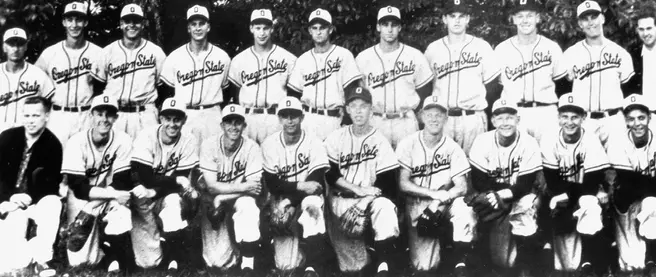1952 Trip To Omaha

Oregon State made its first foray into an NCAA postseason in 1952, and the Beavers also advanced to the College World Series for the first time. Oregon State lost in two games in their inaugural trip to Omaha, but came away with a positive first experience at Omaha Stadium.
The Beavers opened the year by winning the Pacific Coast Conference title and then swept Fresno State in the Western Regional in Corvallis.
“The team of ‘52 was an exceptional collection of raw talent as I look back today,” pitcher Alex Goedhard said years later. “I say raw talent because we had no specialty training. There were no coaches specializing in hitting, fielding, outfield or pitching. There were no physical training regimens for players targeting playing positions outside of daily routine practice. There was no or very little scouting of opposing teams and players.”
• At the Western Regional, on June 7, the Beavers hosted Fresno State in front of a crowd of 4,600, the largest attendance figure to date at what is now Goss Stadium at Coleman Field.
• Oregon State began the season on a high note, winning its first seven games and nine of 10.
• The Beavers had just three losing streaks of two games, with the final one coming in Omaha. Oregon State did not lose consecutive games at home the entire season.
• The 27 victories posted by the Beavers in 1952 set a school single-season record. That record was not surpassed until the 1975 team won 28 games.
• Ralph Coleman was in the midst of his third stint with the team and had another 14 years before ending his illustrious career. Coleman’s two victories in the postseason do not count toward his overall career record, but merely add to 561 victories, then a school record.
• Oregon State’s appearance in Omaha was significant as it was only the sixth-ever College World Series held. The Beavers opened against Duke in just the second-ever meeting between the schools in any sport; the first was in the 1942 Rose Bowl.
• Oregon State used what is now an unusual mode of transportation to arrive in Omaha. The team traveled to Omaha by train on the Union Pacific streamliner City of Portland. The Beavers arrived just after 3 a.m. on a Wednesday.
• Oregon State was the fourth team of what is now known as the Pac-10 to advance to the College World Series. California, USC and Washington St. all advanced to Omaha before the Beavers’ first trip in 1952.
• The games were played at what was then known as Omaha Stadium; it is now known as Rosenblatt Stadium. This marked the third year the CWS was held at Rosenblatt.
• Twenty-seven of the 34 players (79.4 percent) listed on the roster hailed from the state of Oregon.
• Oregon State won its first-ever Pacific Coast Conference Championship in 1952. The Beavers defeated USC in two games; winning game one, 12-10, and taking game two, 5-4, with both contests being played in Corvallis.
• Dwane Helbig became Oregon State’s first All-American in 1952 when the American Baseball Coaches Association named him to the second team. He batted .418 with three home runs and 10 RBI in PCC Northern Division games.
• Bailey Brem and Jay Dean, who were both on the 1952 team, earned All-American honors in 1953 and 1954, respectively. Dean was an All-American in 1955 as well. He was OSU’s first two-time All-American.
The Beavers opened the year by winning the Pacific Coast Conference title and then swept Fresno State in the Western Regional in Corvallis.
“The team of ‘52 was an exceptional collection of raw talent as I look back today,” pitcher Alex Goedhard said years later. “I say raw talent because we had no specialty training. There were no coaches specializing in hitting, fielding, outfield or pitching. There were no physical training regimens for players targeting playing positions outside of daily routine practice. There was no or very little scouting of opposing teams and players.”
• At the Western Regional, on June 7, the Beavers hosted Fresno State in front of a crowd of 4,600, the largest attendance figure to date at what is now Goss Stadium at Coleman Field.
• Oregon State began the season on a high note, winning its first seven games and nine of 10.
• The Beavers had just three losing streaks of two games, with the final one coming in Omaha. Oregon State did not lose consecutive games at home the entire season.
• The 27 victories posted by the Beavers in 1952 set a school single-season record. That record was not surpassed until the 1975 team won 28 games.
• Ralph Coleman was in the midst of his third stint with the team and had another 14 years before ending his illustrious career. Coleman’s two victories in the postseason do not count toward his overall career record, but merely add to 561 victories, then a school record.
• Oregon State’s appearance in Omaha was significant as it was only the sixth-ever College World Series held. The Beavers opened against Duke in just the second-ever meeting between the schools in any sport; the first was in the 1942 Rose Bowl.
• Oregon State used what is now an unusual mode of transportation to arrive in Omaha. The team traveled to Omaha by train on the Union Pacific streamliner City of Portland. The Beavers arrived just after 3 a.m. on a Wednesday.
• Oregon State was the fourth team of what is now known as the Pac-10 to advance to the College World Series. California, USC and Washington St. all advanced to Omaha before the Beavers’ first trip in 1952.
• The games were played at what was then known as Omaha Stadium; it is now known as Rosenblatt Stadium. This marked the third year the CWS was held at Rosenblatt.
• Twenty-seven of the 34 players (79.4 percent) listed on the roster hailed from the state of Oregon.
• Oregon State won its first-ever Pacific Coast Conference Championship in 1952. The Beavers defeated USC in two games; winning game one, 12-10, and taking game two, 5-4, with both contests being played in Corvallis.
• Dwane Helbig became Oregon State’s first All-American in 1952 when the American Baseball Coaches Association named him to the second team. He batted .418 with three home runs and 10 RBI in PCC Northern Division games.
• Bailey Brem and Jay Dean, who were both on the 1952 team, earned All-American honors in 1953 and 1954, respectively. Dean was an All-American in 1955 as well. He was OSU’s first two-time All-American.











